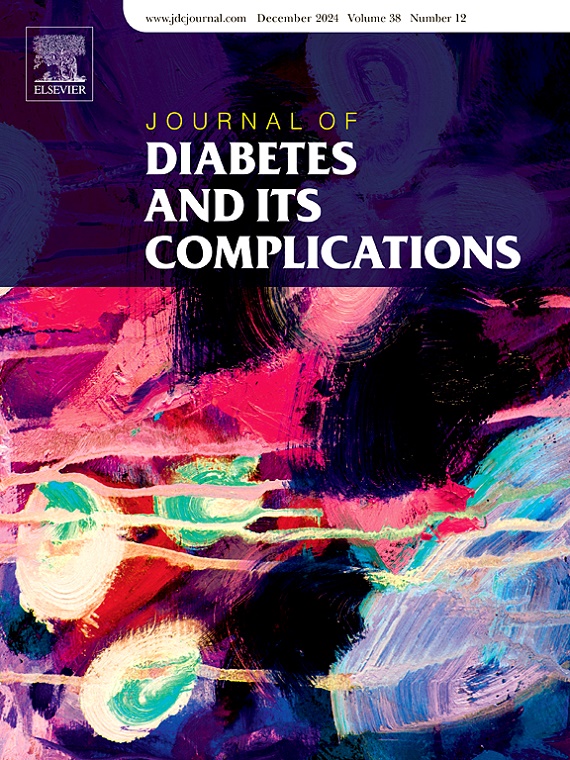Effectiveness of adding glucagon-like peptide-1 receptor agonist on diabetes complications and mortality among basal insulin-treated people with type 2 diabetes: A real-world Korean study
IF 2.9
3区 医学
Q3 ENDOCRINOLOGY & METABOLISM
引用次数: 0
Abstract
Aims
To compare the effectiveness of adding a glucagon-like peptide-1 receptor agonist (GLP-1RA) on composite of diabetes-related complications and mortality with that of adding short-acting insulin (SAI) or shifting to premixed insulin among basal insulin (BI)-treated individuals with type 2 diabetes mellitus (T2DM) in South Korea.
Methods
From the Health Insurance Review and Assessment Service database, individuals with T2DM who initiated BI treatment and had advanced their treatment regimen from July 1, 2012, to December 31, 2018.
Results
A total of 38,634 individuals with T2DM were included in this study. Compared to adding SAI to BI, adding GLP-1RA was associated with decreased risks of cardiovascular complications (hazard ratio 0.56; 95 % confidence interval 0.43–0.72), severe microvascular complications (0.30; 0.19–0.48), diabetes-related hospitalization (0.62; 0.53–0.73), and all-cause mortality (0.27; 0.13–0.57). Compared to switching to premixed insulin, adding GLP-1RA was also associated with lower risk of cardiovascular complications (0.65; 0.51–0.84), severe microvascular complications (0.36; 0.22–0.58), diabetes-related hospitalization (0.62; 0.53–0.73), and all-cause mortality (0.32; 0.15–0.67).
Conclusions
In this real-world Korean study, adding GLP-1RA to BI reduced risks of diabetes complications and all-cause mortality than adding SAI or shifting to premixed insulin.
添加胰高血糖素样肽-1 受体激动剂对基础胰岛素治疗的 2 型糖尿病患者的糖尿病并发症和死亡率的影响:韩国真实世界研究。
目的:比较在韩国基础胰岛素(BI)治疗的2型糖尿病(T2DM)患者中,添加胰高血糖素样肽-1受体激动剂(GLP-1RA)与添加短效胰岛素(SAI)或转向预混胰岛素对糖尿病相关并发症和死亡率的影响。方法:从健康保险审查和评估服务数据库中,从2012年7月1日至2018年12月31日,开始BI治疗并推进治疗方案的T2DM患者。结果:共有38,634例T2DM患者纳入本研究。与在BI中添加SAI相比,在BI中添加GLP-1RA可降低心血管并发症的风险(风险比0.56;95%可信区间0.43-0.72),严重微血管并发症(0.30;0.19-0.48),糖尿病相关住院(0.62;0.53-0.73),全因死亡率(0.27;0.13 - -0.57)。与改用预混合胰岛素相比,添加GLP-1RA也与心血管并发症的风险降低相关(0.65;0.51-0.84),严重微血管并发症(0.36;0.22-0.58),糖尿病相关住院(0.62;0.53-0.73),全因死亡率(0.32;0.15 - -0.67)。结论:在这项现实世界的韩国研究中,在BI中添加GLP-1RA比添加SAI或转向预混胰岛素降低了糖尿病并发症和全因死亡率的风险。
本文章由计算机程序翻译,如有差异,请以英文原文为准。
求助全文
约1分钟内获得全文
求助全文
来源期刊

Journal of diabetes and its complications
医学-内分泌学与代谢
CiteScore
5.90
自引率
3.30%
发文量
153
审稿时长
16 days
期刊介绍:
Journal of Diabetes and Its Complications (JDC) is a journal for health care practitioners and researchers, that publishes original research about the pathogenesis, diagnosis and management of diabetes mellitus and its complications. JDC also publishes articles on physiological and molecular aspects of glucose homeostasis.
The primary purpose of JDC is to act as a source of information usable by diabetes practitioners and researchers to increase their knowledge about mechanisms of diabetes and complications development, and promote better management of people with diabetes who are at risk for those complications.
Manuscripts submitted to JDC can report any aspect of basic, translational or clinical research as well as epidemiology. Topics can range broadly from early prediabetes to late-stage complicated diabetes. Topics relevant to basic/translational reports include pancreatic islet dysfunction and insulin resistance, altered adipose tissue function in diabetes, altered neuronal control of glucose homeostasis and mechanisms of drug action. Topics relevant to diabetic complications include diabetic retinopathy, neuropathy and nephropathy; peripheral vascular disease and coronary heart disease; gastrointestinal disorders, renal failure and impotence; and hypertension and hyperlipidemia.
 求助内容:
求助内容: 应助结果提醒方式:
应助结果提醒方式:


